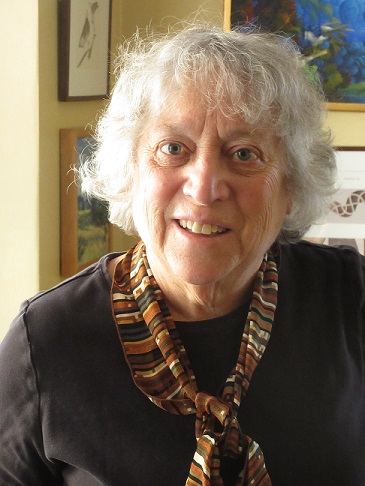
Photo credit: Richard Bock
CWHP Home | Alphabetical Index | Topical Index
Cambridge Women's Heritage Project ~ D ~ |
Dana,
Elizabeth Ellery
Dandelion
School
Daniels,
Mabel Wheeler
D'Antuono,
Eleanor
D ’Arbeloff,
Sybil C.
Daughters
of Bilitis
Davis, Henrietta
Deihl, Marcia
Denison,
Mary (Andrews)
Der-Hovanessian, Diana
Deutsch, Helene (Rosenbach)
Dix, Dorothea Lynde
Driscoll,
Ellen (b. 1954)
DuBois, Cora
Dunlap, Louise
Dunster, Elizabeth (Harris) Glover
Elizabeth
Ellery Dana
(b. 1846 in Cambridge, Mass., d. 1939 in Cambridge, Mass.)
Family and city historian
A daughter of the author Richard Henry Dana, Jr
and Sarah (Watson) Dana, she was a life long resident of Boston and Cambridge
living for most of her life at 152 Brattle St. A graduate of Cambridge Latin
School, she developed a strong interest in the Colonial and Revolutionary history
of Cambridge from the time she was nineteen. She contributed to A Historic
Guide to Cambridge in 1907, and served on the board of the Cambridge Historical
Society. She is responsible for collecting the correspondence, notes, legal
records and photographs of the family preserved at the Longfellow House archives.Her
history of the Dana family The Dana Family in America was published
only after her death. Her papers are useful in reflecting the life of a middle-class
woman of a well-known family.
References:
Finding aid, Elizabeth Ellery Dana Personal Papers,
Longfellow House archives. Cambridge
Additional correspondence in the Dana
papers in Houghton, Harvard University Library.
Dandelion
School (founded
1971 in Cambridge, Mass.)
Pre-school
This school for young children was opened and co-founded by Kathy Roberts and
Beth Rumnorzy in 1971 in Cambridge. It is a childcare center influenced by the
Freedom Schools of the 1960s, with a peace and justice philosophy. Freedom Schools
were temporary, alternative free schools for African Americans. They were originally
part of a nationwide effort during the Civil Rights Movement to organize African
Americans to achieve social, political and economic equality in the United States.
The most prominent example of Freedom Schools was in Mississippi in the August
of 1964.
Kathy Roberts remained as the director from 1971
to 2002. She envisioned the school as a place where the young children could
escape the media barrage of
commercial toys and programs and “focus on topics from nature, children's
own experiences and literature.” She also felt that this would provide
children with some ability to handle the influence of television when they
entered elementary school.
Reference: Teaching Tolerance magazine Number
24, Fall 2003.
Mabel
Wheeler Daniels (b. November 27, 1876 in Swampscott, Mass.,
d. March 10 1971 in Cambridge, Mass.)
Composer
Mabel Wheeler Daniels was the daughter of Sarah
(Wheeler) and George Frank Daniels. Her father who was in shoe manufacturing
was the president of the Handel and Hayden Society and he introduced his daughter
to music at a young age as had both her grandfathers who were church organists.
She attended Girls Latin School in Boston and then went to Radcliffe College
where she sang in the Glee Club and directed operettas. She also studied composition
and began to compose choral music. After graduating in 1900, she studied for
two years at the New England Conservatory of Music and then went to Germany
to study in the Royal Conservatory of Munich. On returning to America, she published
a book on her experiences in Munich (An American Girl in Munich) in,
1905 and proceeded to direct the Radcliffe Glee Club and music director at Simmons
Glee Club. She sang soprano in the Cecilia Society and began to win prizes for
her composition. Marion MacDowell produced the first performance of her cantata,The
Desolate City (1913) at the MacDowell Colony following which she was regularly
invited to use the studios of the colony in Petersborough NH to create her musical
compositions. Although her first compositions were more conventional, she became
interested in modern music while preparing a piece for soprano, chorus and orchestra
based on a poem The Song of Jael (1940) by her friend Edwin Arlington
Robinson. Her pieces began to be played by major artists, by the Boston Symphony
Orchestra, and in programs of significant American music in Carnegie Hall, and
for NBC radio. She made important gifts to women’s colleges to support
young women musicians and served as an alumnae trustee of Radcliffe College
from 1940-1951. Her papers are held at Schlesinger Library, Radcliffe Institute.
References:
Notable American Women, Modern Period
(1980)
Madeline Goss, Modern Music-Makers: Contemporary American Composers
New York, (1952)
Biography, Finding Aid Mabel Wheeler Daniels Papers, Schlesinger
Library, Radcliffe Institute.
Eleanor
D’Antuono (b. 1939 in Cambridge, Mass.)
Dancer
Eleanor D’Antuono was born in Cambridge
and trained in ballet by the founders of the Boston Ballet. She joined the American
Ballet Theater in 1961 and was a principal dancer from 1963, gaining wide recognition
for her roles in Giselle, Swan Lake, and Petrouchka. Choreographers Alvin Ailey
and Lorenzo Monreal created original roles for her in their ballets. She was
the first American ballerina to be invited to perform as a special guest artist
with the Kirov Ballet of Leningrad (now St. Petersburg) in 1978 and 1979, where
she danced in Giselle and performed the role of Odille in Swan Lake, touring
other Soviet cities with them. She was also the first American ballerina to
appear with Chinese companies. After retiring, she coached professional and
regional ballet companies nationwide, staged many classical ballets, and served
as the artistic director of a number of ballet companies, and most recently
served as artistic director of the New York International Ballet Competition.
References:
Phyllis J. Read and Bernard L. Witlieb The
Book of Women’s Firsts, 1992.
Carolyn Warner,Treasury of Women’s Quotations, 1992; New York
International Ballet Competition online site http://www.nyibc.org/about.htm
as retrieved on May 19, 2006
Sybil
C. D’Arbeloff (b. ca 1931, d. 2000 in Cambridge, Mass.)
Hospital administrator
In 1992, Sybill d’Arbeloff was the first
women to be elected chairman of the board of a Harvard Teaching Hospital. Served
as the director of development of Mt. Auburn Hospital. A trustee of the hospital
since 1986, she continually demonstrated her commitment to the hospital and
community service. In addition to her contributions to Wheaton College and Mt
Auburn Hospital, she served as a member of Cambridge Community Foundation. She
was a member of the Board of Overseers at the Museum of Science and WGBH, and
was an associate of the Museum of Fine Arts. She was recognized by many organizations
for her community service including Women in Philanthropy and the New England
Association for Hospital Philanthropy. She was awarded the Cambridge YWCA’s
Tribute to Women Award in 1993. She was 69 when she died.
Reference: Cambridge Chronicle 1-17-01
Daughters
of Bilitis (DOB)
Feminist and lesbian rights organization
The Cambridge Chapter of DOB is one of the
surviving chapters of one of the first lesbian rights organizations formed in
San Francisco by Del Martin, Phyllis
Lyon, and six other women. It was created initially to provide an alternative
to the gay bar scene. Bilitis was the fictional lesbian lover of Sappho as described
in the poetry of Pierre Louÿs in Songs of Bilitis (1894). The “Daughters
of Bilitis” name was intended as a sly reference to conservative organizations
like the Daughters of the American Revolution and other similar groups. The DOB
achieved national prominence during the 1950s and 1960s, but split over disagreements
in the 1970s about whether it should support gay rights or feminism. During its
heyday, it had chapters throughout the US and Australia. Between 1959 and 1972,
the DOB
published a national newsletter, The Ladder. Among the notable women
who joined the organization were the playwright, Lorraine Hansberry, and the
activist,
Barbara
Gittings.
Reference: Gallo, Marcia M. Different Daughters: A history
of the Daughters of
Bilitis and the Birth of the Lesbian Rights Movement, Carroll & Graf, 2006.
Henrietta Davis (b. 1945 in Newton, Mass.)
Former Mayor, City Councilor, and School Committee Member, City of Cambridge
Raised in Newton, Massachusetts, Henrietta Davis graduated from University of Rochester in 1967 with a degree in English Language and Literature. She earned a Master Degree in Community Organization and Social Planning from Boston College Graduate School of Social Work in 1972, which included coursework in public policy and city planning at Massachusetts Institute for Technology. In 1996, she received a Master of Public Administration from Harvard University JFK School of Government. She is a longtime resident of Cambridgeport, MA, where she and her husband Richard Bock raised their two sons, Daniel and Aaron.
Davis began her career in neighborhood planning for the city of Cambridge, and later worked as a journalist for NPR, Time, The Boston Herald, The Boston Globe and Money magazine. In 1982, Davis became an administrator at her son’s school, the Agassiz Preschool, a parent cooperative community. Davis cites the successful democratic decision making process at the school as one of the reasons she chose to run for local office and pursue a career in politics. From 1987 to 1995, Davis served four terms on the Cambridge School Committee, where she focused on developing the science curriculum and AIDS prevention. Davis also was a founder and co-chair of the Healthy Children’s Task Force, that promotes healthy eating, increased physical activity for kids, gardens in all elementary schools and school wellness policies. The Task Force was an early and successful initiative for its time.
In 1994, Davis was elected to the Cambridge City Council, and served eight terms, including two as the City’s Vice Mayor. Davis worked on a wide range of issues, especially city livability and environmental sustainability. Her efforts resulted in Cambridge’s adoption of a Green Building policy for new buildings, and the Cambridge Compact for a Sustainable Future and the Net Zero Task Force. Davis also represented Cambridge nationally with leadership roles at the National League of Cities (NLC), as Chair of the NLC Energy, Environment and Natural Resources Committee and the NLC University Community Council, and as Board member for the International Council for Local Environmental Initiatives (ICLEI).
Davis was elected the Mayor of the City of Cambridge in 2012, serving for two years. During her term, Davis focused on pedestrian and bicycling safety, neighborhood preservation, housing and issues especially important to children and seniors. Continuing her work from her early years on the School Committee, she fostered partnerships between MIT, Harvard, business and community organizations to work on issues related to urban planning, sustainable development and STEAM education. After she retired from city government, Davis continues to be an advocate for environmental issues, as a board member for the Mass Climate Action Network, the USGBC-MA, the green building council, and the Institute for Market Transformation, a national organization promoting energy efficiency in buildings. Davis also attended the Paris Climate Talks in 2015. Davis divides her time between sustainability and artistic ventures, including drawing, watercolor painting and printmaking.

Photo credit: Richard Bock
References:
Henrietta Davis website bio, http://www.henriettadavis.org
Oral history interview with Henrietta Davis, https://infinitehistory.mit.edu/video/henrietta-davis
Board Member Bio, ICLEI, http://icleiusa.org/about-us/who-we-are/board/mayor-henrietta-davis-2/
Marcia Deihl (b. July 20, 1949 in Asheville, North Carolina, d. March 11, 2015 in Cambridge, MA)
Singer, Songwriter, Writer, Diarist and Political Activist
Marcia Deihl was a folk musician, singer, writer, political and cultural activist and founding member of The New Harmony Sisterhood Band, a feminist folk five-member string band. Deihl was born in Asheville, North Carolina to Martha “Polly” Deihl and Rev. R. Irving Deihl, and spent her childhood in New York state. Both her parents were singers and performers, and Deihl’s mother received numerous awards recognizing her service to her community. Deihl moved to Boston to study music history and education at Boston University, where she earned a bachelor’s degree. She received a master’s degree in feminism and folk music from Cambridge-Goddard School for Social Change and a certificate in publishing and communications from Harvard University.
Deihl worked for 30 years at Harvard’s Tozzer Library. She died tragically in a bike accident in Cambridge, just as she began her retirement. Her brother David Deihl survives her, as well as nieces and nephews and cousins.
Deihl wrote songs, essays, parodies and poems, transcribed folk music, contributed frequently to the Boston Globe’s letters to the editor, was published on WBUR’s Cognoscenti and kept a daily diary. Her publications, as writer, co-author and editor, include All Our Lives: A Women’s Songbook (1976), “Biphobia” with Robyn Ochs (1992, 2010), “Inventing a radical feminist bisexuality”, and a transcription of Charlie King’s songbook “Songs for the Current Millennium” (2013). Deihl’s papers on women’s music and her daily diaries, which span 50 years, will become part of the archives of the Schlesinger Library on the the History of Women in America at the Radcliffe Institute for Advanced Study. Her writings for the Bisexual Resource Center are now part of the Northeastern University Libraries Archives and Special Col-lections.
In 1973, Deihl co-founded The New Harmony Sisterhood Band with Deborah Silverstein while students at Goddard-Cambridge Graduate School for Social Change. The group produced several records and regularly performed at gay and lesbian marches and rallies, women’s celebrations, union drives and nuclear power protests, and went on tour, performing in Philadelphia, Virginia, North Carolina and Kentucky. The band’s 1977 record “And Ain’t I a Woman?” is in the Smithsonian Center for Folklife and Cultural Heritage. In 2006, the album was reissued by Smithsonian Folkways Recordings, the nonprofit record label of the Smithsonian. The record was inspired by Sojourner Truth’s Speech at the 1851 Women’s Convention in Akron, Ohio. Songs on that album include “Union Maid”, “Cotton Mill Girls” and “Ballad”. “Union Maid” appeared on HBO’s 8th episode of the show “Enlightened” featuring Laura Dern.
Deihl loved folk music, gospel and union hymns. She sang in the choir of the Old Cambridge Baptist Church and she performed on guitar and mandolin and sang in several other bands, including the Bunker Mountain Fiddlers, Otis Grove, Cowfolks’ Dream, the Oxymorons and the Raisinettes. Deihl also taught music in history workshops, such as “Songs of Social Justice” and “Women’s History Through Song,” and was known locally for hosting “Bizarre Song Parties” at her home.
Deihl was a longtime member and supporter of many social justice and community organizations, including the Harvard Union of Clerical and Technical Workers, the Old Cambridge Baptist Church’s racial justice committee, the Cambridge Peace Commission, the Bisexual Resource Center, the People’s Music Network and an early member of the Cambridge Women’s Heritage Project. She co-founded the Boston Bisexual Women’s Network and was a volunteer and supporter of the Theater Offensive, a LGBTQ theater company. Additionally, she performed for many Cambridge organizations throughout her career.
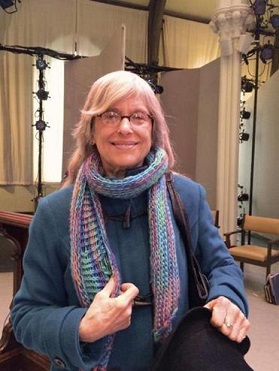
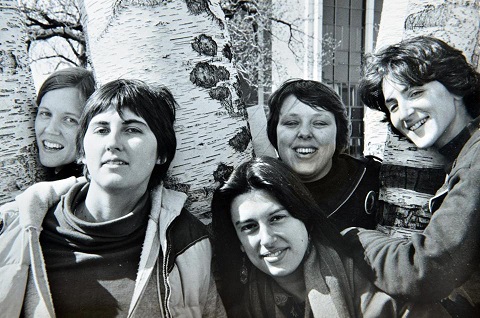
(left image) Photo
by Betsy Sowers.
(right image) Photo courtesy of Deborah Silverstein. Pictured: Marcia Diehl, at center, with bandmates of the New Harmony Sisterhood Band--Katie Tolles, Kendal Hale, Pat Oullette and Deborah Silverstein.
References:
Deihl, Marcia. “Marcia Deihl Home.” Marcia-Mellow-D Blogspot. 2013. <http://marcia-mellow-d.blogspot.com>.
Deihl, Marcia. Papers of Marcia Deihl, 1965-2011 (inclusive). Schlesinger Library on the History of Women in America, Radcliffe Institute for Advanced Study, 2009-M153, 2016-M80. Web. 31 March 2019. <http://id.lib.harvard.edu/alma/990120776210203941/catalog>.
Ely, Elissa. “Marcia Deihl.” The Remembrance Project. WBUR. Boston, Massachusetts. July 7, 2015. Radio. <https://www.wbur.org/remembrance-project/2015/07/07/the-remembrance-project-marcia-deihl>.
Hale, Kendall. Radical Passions. Bloomington: iUniverse, 2008. E-book.
New Harmony Sisterhood Band. …And Ain’t I a Woman, Paredon Records, 1977. Smithsonian Center for Folklife and Cultural Heritage. Web. 31 March. 2019. <https://folkways.si.edu/new-harmony-sisterhood-band/and-aint-i-a-woman/african-american-music-folk-struggle-protest/album/smithsonian>. <https://sirismm.si.edu/EADpdfs/CFCH.PARE.pdf>.
Seligson, Susan. “The Good Life of Marcia Deihl.” Bostonia. Winter Spring, 2016. <http://www.bu.edu/bostonia/winter-spring16/marcia-deihl-cambridge/>.
Mary
(Andrews) Denison (b. May 26 1826 in Cambridge, Mass., d. October
11 1911 in Cambridge, Mass.)
Popular novelist
Mary Andrews was daughter of Thomas Jefferson
Andrews and his wife Juliette Robbins She was educated in the Boston public
schools and in 1846, married a Baptist Minister Rev. Charles Wheeler Denison,
editor of the Emancipator, the first antislavery journal in New York.
When her husband became an assistant editor to the Boston Olive Branch,
the journal published her first written piece. In 1847, she published her first
novel, Edna Etheril, The Boston Seamstress, which was a success. During
her lifetime, she published over eighty novels, writing under the pen names
of N. I. Edson and Clara Vance. She also crusaded against alcohol in her book,
Gertrude Russel (1849), published by the American Baptist Publication
Society. Her novels, written in a lively style with colorful dialogue often
depicted poor and struggling individuals overcoming temptations, concluding
with the triumph of good over evil. With titles such as Out of Prison
(1864), Carrie Hamilton (1866), Led to the Light (1867.) That
Wife of Mine (1877) and Cracker Joe (1889) she endorsed conservative
religious and social ideas, but did so with humor. Denison also contributed
on a continuous basis to a number of popular periodicals, principally Frank
Leslie’s Monthly, Harper’s Weekly, the People’s
Home Journal, and Youth’s Companion. During the last two
years of the Civil War, her husband was a hospital chaplain in Washington D
C and Mary served as a volunteer nurse. Soon after, the couple went to England
where he wrote articles in defense of the Northern cause and later edited an
American newspaper. In 1867 they returned to Washington where they lived for
many years. After his death in 1881, she remained at her home in Baltimore.
Fourteen months before her death she came back to Cambridge to live in the house
of her brother Dr. R. R. Andrews, where she died.
References:
American Women Writers (1979)
Boston
Evening Transcript, October 17, 1911
Diana
Der-Hovanessian (b. May 21, 1934 in Worcester, Mass., d. March
1, 2018 in Cambridge, Mass.)
Poet, translator
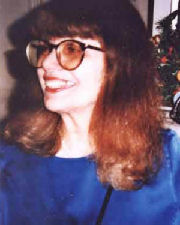 Of
Armenian heritage, Diana Der-Hovanessian she was born and lived until age five
in Worcester, Massachusetts where her grandparents also lived. She was early
influenced by the Armenian martyr poets Siamanto and Daniel Varoujan, whose
work her father recited to her in Armenian. As a full fledged poet, she later
translated their work and the work of other Armenian poets into English with
her father. She often writes original poetry that reflects the history of her
Armenian ancestors. As a young child, her mother also recited American and English
poems that also served as inspirations.
Of
Armenian heritage, Diana Der-Hovanessian she was born and lived until age five
in Worcester, Massachusetts where her grandparents also lived. She was early
influenced by the Armenian martyr poets Siamanto and Daniel Varoujan, whose
work her father recited to her in Armenian. As a full fledged poet, she later
translated their work and the work of other Armenian poets into English with
her father. She often writes original poetry that reflects the history of her
Armenian ancestors. As a young child, her mother also recited American and English
poems that also served as inspirations.
Der-Hovanessian attended Boston University where
she obtained an A.B. and later did graduate work at Harvard where she studied
with Robert Lowell. She first worked as a journalist on the Medford Mercury
and then in New York City. She married James Dalley, with whom she had two daughters.
Diana Der-Hovanessian is the author of twenty-three books of poetry and translations
and has received numerous awards from the National Endowment for the Arts, the
Poetry Society of America, the National Writers Union, and PEN-Columbia Translation
Center, among others. Her work has appeared in publications such as Paris
Review, Nation, Partisan Review, American Scholar,
New York Times, Poetry, and AGNI Magazine. Recently,
Garrison Keillor has read poems from her books on the radio on his `Writer's
Almanac' on National Public Radio.
She taught workshops in translation, poetry of
human rights, at various universities and at the Boston Globe Book Festival.
She was Fulbright professor of American poetry at Yerevan State University in
the Republic of Armenia in 1994, and 1999. She was President of New England
Poetry Club (founded by Amy Lowell in Cambridge) for twenty years. She also
started the summer poetry reading festivals at the Longfellow house on Brattle
Street. She died in Cambridge, Mass. in 2018.
References:
Sally Cragin, “Worcester-born poet Diana Der-Hovanessian visits the old
neighborhood,” The Worcester Phoenix, November 12 - 19, 1999
McIntire, D. International Who’s Who in Poetry and Poets' Encyclopedia,
Routledge, 2001, p. 139-40.
http://www.cervenabarvapress.com/der-hovanessianinterview.htm
http://www.dianaderhovanessian.com
http://www.armeniapedia.org/index.php?title=Diana_Der-Hovanessian
Helene
(Rosenbach) Deutsch (b. October 9 1884 in Przemysl, Poland d.
March 29, 1982 in Cambridge, Mass.)
Psychoanalyst
Helene (Rosenbach) Deutsch was born in Przemysl,
Poland to Wilhelm and Regina Rosenbach. As a young girl she wrote for the local
newspaper and planned to attend university against the wishes of her family.
In 1910, she went to study medicine in Munich, graduating with a Doctorate in
Medicine in 1912. That same year, she married a physician, Felix Deutsch. Soon
after, she began to work at the Vienna Psychiatric Clinic under Julius Wagner-Jauregg,
and then went to Munich to study with Emil Kraepelin. After a series of miscarriages,
she had one son, Martin in 1917. During her studies in Munich, she had read
Sigmund Freud’s Interpretation of Dreams which determined her
to become a psychoanalyst. In 1916, she began to work with Freud, first attending
his Wednesday night meetings, then joining his Vienna Psychoanalytic Society
two years later. She was one of the first women to join and one of the first
women to be analyzed by Freud.
From 1925 to 1933, Deutsch was director of Freud’s
Vienna Psychoanalytic Clinic that trained psychoanalysts. She published her
first book, The Psychology of Women's Sexual Functions, the first psychoanalytic
study of women by a woman. With the rise of Hitler in 1934 and the take-over
of Austria the following year, Helene Deutsch, with her son, fled Austria for
the United States. When her husband joined her the next year, they settled in
Cambridge, Massachusetts where she lived for the rest of her life. She became
an Associate Psychiatrist at the Massachusetts General Hospital and an active
member of the Boston Psychoanalytic Society, publishing a two volume book on
women's psychology, The Psychology of Women (1944-45). In 1964, Deutsch's
husband, Felix, died . She continued to live an active professional life, publishing
an interesting memoir Confrontations with Myself. (1972). She died
in 1982 in Cambridge at the age of 97. Her papers, including some correspondence
with Freud, are deposited at Schlesinger Library.
References:
Sayers, J. Mothers of Psychoanalysis.
New York, 1991.
Roazen, Paul. Helene Deutsch, A Psychoanalyst's Life,
(Garden City, N.Y, 1985)
Finding aid, Helene (Rosenbach) Deutsch papers, Schlesinger
Library.
Dorothea
Lynde Dix (b. April 4, 1802, Hampden, Maine, d. July 18, 1887
in Trenton, New Jersey)
Educator, Reformer
Dorothea
Dix was the daughter of Joseph and Mary (Bigelow) Dix. She opened her own school
for young children in Worchester. Her talent as a teacher was so great that
in 1819, she opened a school for girls in Boston but was forced to close it
because of illness. Dorothea wrote several books for young readers, including
an elementary science textbook, Conversations on Common Things (1824),
Hymns for Children (1825), and American Moral Tales for Young Persons
(1832). In 1831, Dix opened a new school in Boston, where she taught until 1836,
until she collapsed from phsycial and nervous exhaustion. While recuperating
in Liverpool, England, she met several leading British reformers who shared
with her their new ideas about the treatment of the mentally ill. In 1838, Dix
returned to America to live quietly on the income left to her upon the death
of her grandmother. Three years later, when a Harvard Divinity student asked
her to teach Sunday school classes for women at the East Cambridge House of
Correction she discovered that some women were incarcerated simply
Dorothea Lynde Dix, undated.
Library of Congress Prints and Photographs Division.
because they were mentally
ill. Dix began to publicly expose the deplorable conditions in which both prisoners
and the mentally ill were housed. With the support
of Boston social reformers, such as Senator Charles Sumner and his close friends
Samuel Gridley Howe, and Horace Mann, Dix spent the next eighteen months surveying
jails, almshouses, and hospitals across the state. She then presented the Massachusetts
Legislature with her findings, resulting in the immediate enlargement of the
Worcester Asylum.
Despite her recurring health problems, Dix expanded
her investigations of conditions for the insane and mentally retarded throughout
New England, New York, and eventually throughout most of the country. She pushed
state governments to assume their proper care by producing “memorials”
describing the appalling conditions. Altogether, Dix inspired the establishment
of 32 state hospitals and 120 private and county hospitals. She expanded her
survey to the prisons and published a book Remarks on Prisons and Prison
Discipline in the United States (1845). During the Civil War, she was named
superintendent of army nurses and caused controversy when she excluded those
attached to religious orders or anyone under thirty. After the war, she continued
to visit hospitals, expanding her surveys to the South. She died in New Jersey,
worn out at the age of eighty-five and was buried in Mount Auburn Cemetery,
Cambridge.
References:
Ogilvie, Marilyn and Joy Harvey. Biographical
Dictionary of Women Scientists. Routledge Press, 2000
Notable American
Women (1950) Vol I.
Ellen
Driscoll (b. 1954)
Sculptor, Public Artist
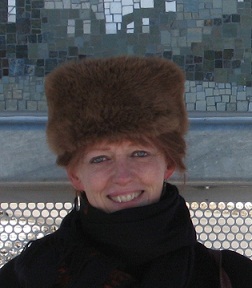 Ellen
Driscoll is the daughter of Philip Driscoll and Eileen Driscoll. She earned
her BA from Wesleyan University, in Connecticut and her MFA from Columbia University.
She is a professor of sculpture at the Rhode Island School of Design. Driscoll
is known for elaborate projects including, in SoHo, Manhatten, a huge installation
of mechanized sculptures inspired by the 19th-century medical conception of
hysteria, "Passionate Attitudes," (1995). She has designed a prize-winning
public art work, “Filament/ Firmament,” scheduled to be installed
in the new Cambridge Public Library and designed to be two stories high. It
will honor the contributions of women to the life of the city and explores the
theme of weaving, a universal activity that links together women of every culture.
She lived in Cambridge for a number of years but moved in 2007 and now resides
in Brooklyn, New York.
Ellen
Driscoll is the daughter of Philip Driscoll and Eileen Driscoll. She earned
her BA from Wesleyan University, in Connecticut and her MFA from Columbia University.
She is a professor of sculpture at the Rhode Island School of Design. Driscoll
is known for elaborate projects including, in SoHo, Manhatten, a huge installation
of mechanized sculptures inspired by the 19th-century medical conception of
hysteria, "Passionate Attitudes," (1995). She has designed a prize-winning
public art work, “Filament/ Firmament,” scheduled to be installed
in the new Cambridge Public Library and designed to be two stories high. It
will honor the contributions of women to the life of the city and explores the
theme of weaving, a universal activity that links together women of every culture.
She lived in Cambridge for a number of years but moved in 2007 and now resides
in Brooklyn, New York.
Her other public art has included a suite of glass
and mosaic murals for the New York City subway system and a glass work titled
"As Above, So Below" for Grand Central Terminal, intended to express
cosmological theories, the movement of the sun, moon, and stars as drawn from
beliefs of various cultures. She has held fellowships from the Guggenheim, National
Endowment for the Arts, the Massachusetts Cultural Council, and Radcliffe Bunting
Institute, among others. Her work is included in a variety of museum collections
including the Metropolitan Museum and Whitney Museum.
References:
Charles Hagen, “Review/Art
When the Outside World Is Danger New York Times December 27, 1991
Cambridge Arts Council online site: http://www.ci.cambridge.ma.us/CAC/public_progress_5.html
Ellen Driscoll online site: http://www.ellendriscoll.net
Cora
DuBois (b. 1903 in Brooklyn, N.Y., d. 1991 in Brookline, Mass.)
Anthropologist
Educated at Barnard, Cora Du Bois obtained her
Ph.D. at University of California, Berkeley in 1932.. After teaching at U.C.
Berkeley, she became interested in the links between psychology and anthropology,
and began to work with Henry A. Murray and Abram Kardiner. She then taught at
Hunter College and began ethnographic field work in Alor, Indonesia During World
War II , she worked with the Office of Strategic Services as research chief
of the Indonesia Section.and then with the State Department (1943-1949). In
1954, she was offered the Radcliffe College Zemurray Professorship and taught
in the Department of Anthropology and the Department of Social Relations at
Harvard until 1970, becoming the second woman to be tenured at Harvard. Her
field work continued in both Indonesia and India, where she studied sociocultural
change at an Indian temple city and supervised a number of Harvard doctoral
theses. In 1970, she retired from Harvard and went to Cornell where she remained
for five years as Professor-at-large. She returned to Brookline at the end of
her life where she died at the age of 88.
References:
Ogilvie, Marilyn and Joy Harvey. Biographical Dictionary
of Women Scientists. Routledge Press, 2000
Louise
Dunlap (b.July 27 1938 in Berkeley, Calfornia)
Writer, teacher, social activist
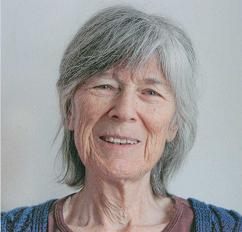 Born
in Berkeley to Elizabeth and David Dunlap, Louise Dunlap attended the University
of California, Berkeley where she studied literature to the level of the PhD.
During the 1964 Free Speech movement on the Berkeley campus, she first taught
writing on behalf of the cause of social justice. She came to Cambridge in 1967.
She was married for ten years, divorcing in 1977. After teaching for ten years
at UMass Boston, she began, in 1980, to teach writing as a lecturer in the Urban
and Planning Department at MIT. In 1990, she encouraged Cambridge residents
to join in the Bigfoot Memorial Ride in commemoration of the centennial of the
Wounded Knee massacre of the Sioux Indians. In 1994, she left MIT but continued
to teach at the Department of Urban and Environmental Policy and Planning at
Tufts where she has continued to introduce students to her writing techniques.
Born
in Berkeley to Elizabeth and David Dunlap, Louise Dunlap attended the University
of California, Berkeley where she studied literature to the level of the PhD.
During the 1964 Free Speech movement on the Berkeley campus, she first taught
writing on behalf of the cause of social justice. She came to Cambridge in 1967.
She was married for ten years, divorcing in 1977. After teaching for ten years
at UMass Boston, she began, in 1980, to teach writing as a lecturer in the Urban
and Planning Department at MIT. In 1990, she encouraged Cambridge residents
to join in the Bigfoot Memorial Ride in commemoration of the centennial of the
Wounded Knee massacre of the Sioux Indians. In 1994, she left MIT but continued
to teach at the Department of Urban and Environmental Policy and Planning at
Tufts where she has continued to introduce students to her writing techniques.
Dedicated to Buddhist peace missions, Louise was
a key organizer for the Interfaith Pilgrimage of the Middle Passage when it
came to Boston and Cambridge in 1998. She participated in the pilgrimage, for
which she walked about one thousand miles. In the same spirit she helped organize
local routes for the justice and peace Buddhist sponsored Walks for a New Spring.
She has written for many periodicals including the American Friends Service
Committee’s PeaceWork and the Buddhist Peace Fellowship's, Turning
Wheel. Her book on writing for social change: Undoing the Silence:
Six Tools for Social Change Writing was published in November 2007 by New
Village Press. (http://www.undoingsilence.org)
Louise Dunlap. Photo by Skip Schiel
Since
1995, Dunlap has lived in one of Cambridge's limited equity coops and contributes
to its self management. She continues to teach writing workshops for community
activists and has taught yoga since 1976 including a community class in Central
Square that ran for nine years to benefit the Cambridge Eviction Free Zone.
A slide show, "Walk the Witness," about Buddhist-led pilgrimages and
peace walks produced by Louise Dunlap’s then-partner, photographer Skip
Schiel, with the participation of Louise Dunlap, appears on Schiel’s website.
Dunlap was a member of the Cambridge Peace Commission from 1998-2008. She is
a member of the Order of Interbeing formed by Vietnamese Buddhist teacher Thich
Nhat Hanh to link and support peacemakers.
References:
Information from Skip Schiel and Louise Dunlap
Louise Dunlap, “Hiroshima Flame Interfaith Pilgrimage” Peacework
December 2001
“Hiroshima Flame at New York’s Ground Zero” PeaceWork,
September 2002
Vanessa E. Jones "The way of oneness"
Boston Globe April 19, 2006
Elizabeth
(Harris) Glover Dunster (b. ca 1600 in England, d. August 1643
in Cambridge, Mass.)
First Proprietor of a Printing Press in America -1638
Elizabeth Harris Glover established the first printing office in colonial America.
Around the year 1630, Elizabeth Harris married Reverend Joseph (sometimes referred
to as Jose or Josse) Glover in England with whom she had three children. Joseph
Glover had been a minister in Surrey, England, but left his family to come to
Boston as a member of the Massachusetts Bay Company, through which he obtained
a two hundred acre farm near Boston. He returned to England in 1638 to bring
over his family, which included Elizabeth, their three children, and another
two children from his previous marriage. The family brought with them a printing
press and other supplies. Also on board was Stephen Daye, a locksmith by trade
who was contracted to Glover, and Daye's family. Unfortunately, Joseph Glover
died on their ocean voyage of a fever in 1638.
Elizabeth.Glover, with the approval of local magistrates and elders, set up the
printing press in Cambridge and settled in a house in close proximity to Harvard
College and bought another house in which the Daye family lived and operated
the printing press (later to become the Cambridge Press), that printed the first
books in the colonies, The Whole Book of Psalmes, The Liberties
of the Massachusetts
Colonie in New England (now in the Boston Athenaeum), and the Almanack for the
Years of 1639, 40, and 41.
In 1641, Elizabeth Glover married Henry Dunster, president of Harvard from 1640-1654,
who took over the supervision of the printing business upon her death in 1643.
The Glover children later sued Dunster for a share of the estate.
References:
Hudak, Leona M. Early American Women Printers
and Publishers 1639-1820,
The Scarecrow Press, Inc.
Metuchen, New Jersey, 1978.
Cambridge Historical
Society Proceedings, vol. III:12-17; VI:22; XDIV: 64
See also History
of Printing
in America (1878).
Cambridge
Women's Heritage Project
April 2019